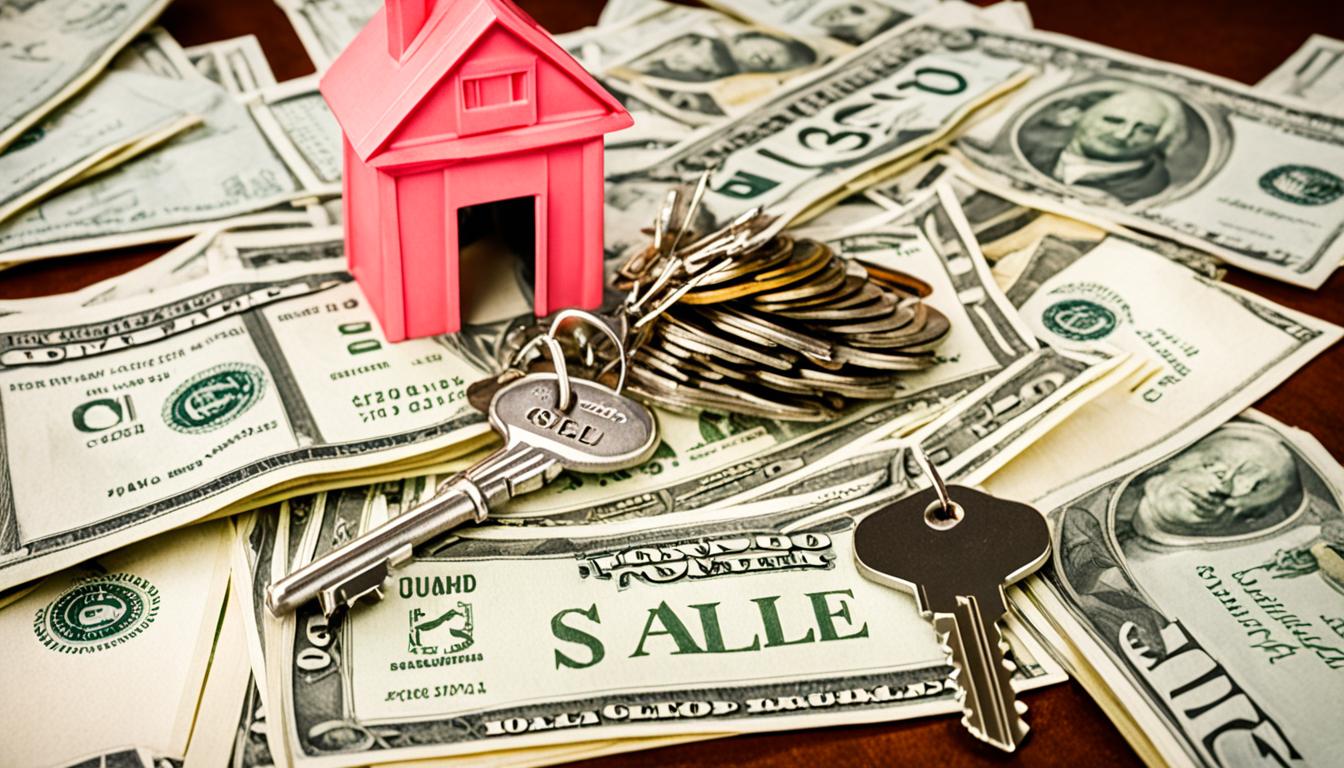Sometimes, life throws unexpected financial challenges our way or presents opportunities that require additional funding. In such situations, cash mortgage refinance can be a smart solution to simplify your finances and access the equity in your home. Whether you’re looking to tackle high-interest debts, invest in home improvements, or pursue other financial goals, cash mortgage refinance offers a straightforward and efficient way to meet your needs.
With cash-out mortgage refinance, you can convert your home equity into cash, providing you with the funds you need upfront. By refinancing your mortgage for cash, you’ll receive a loan with a higher balance, and the difference between the new loan amount and your existing mortgage is disbursed to you in cash. This cash can be used for any purpose you desire, giving you the financial flexibility you need to achieve your goals.
When considering a cash mortgage refinance, it’s important to explore various options and weigh their benefits. Look for lenders that offer refinancing for cash, providing you with the opportunity to access your home equity and benefit from lower interest rates. Some lenders even offer mortgage refinance with cash back, allowing you to receive cash at closing. These cash refinancing options can be highly advantageous for homeowners who need immediate funds.
Key Takeaways:
- Cash mortgage refinance allows homeowners to access their home equity and receive cash.
- Refinancing for cash provides financial flexibility to tackle various needs, such as debt consolidation or home improvements.
- Consider lenders that offer cash refinancing options, including cash-out mortgage refinance and mortgage refinance with cash back.
- Explore the benefits of refinancing your mortgage for cash, including lower interest rates and the ability to simplify your finances.
- Consult with professionals to determine the best cash mortgage refinance options that align with your financial goals.
Eligibility and Requirements for Cash-Out Refinance
To be eligible for a cash-out refinance, homeowners must meet certain criteria and requirements. Understanding these eligibility factors is crucial before considering a cash-out refinance for your home.
Loan-to-Value Ratio
One of the key eligibility requirements for a cash-out refinance is the loan-to-value (LTV) ratio. Typically, lenders prefer an LTV ratio of 80% or less, meaning that homeowners should have at least 20% equity in their property. This ensures that the cash-out refinance does not exceed the value of the home.
Credit Score
A good credit score is an essential factor in qualifying for a cash-out refinance. While conventional loans usually require a minimum credit score of 620, government-backed loans may have more flexible criteria. Lenders use credit scores to assess the borrower’s creditworthiness and determine their ability to repay the loan.
Income and Debt-to-Income Ratio
Lenders also evaluate the homeowner’s income and debt-to-income (DTI) ratio. The DTI ratio compares the homeowner’s monthly debt payments to their gross income. Lenders generally prefer a DTI ratio of 43% or lower. A stable income and a low DTI ratio indicate financial stability, making the homeowner more eligible for a cash-out refinance.
Appraisal Process
An appraisal is necessary to determine the current market value of the home. This appraisal ensures that the property’s value supports the cash-out refinance amount and helps maintain the desired LTV ratio. Lenders typically require a professional appraisal to assess the property’s worth accurately.
By meeting these eligibility requirements, homeowners can increase their chances of qualifying for a cash-out refinance. It’s essential to consult with a mortgage professional to fully understand the eligibility criteria and explore the available options tailored to your financial situation.
<!–
| Eligibility Requirements | Description |
|---|---|
| Loan-to-Value Ratio | 80% or less to maintain the desired equity and refinance amount. |
| Credit Score | Minimum credit score requirements vary by loan type. |
| Income | Stable income plays a vital role in demonstrating the ability to repay the loan. |
| Debt-to-Income Ratio | A low DTI ratio indicates a manageable debt load and better financial stability. |
| Appraisal Process | Professional appraisal to determine the property’s current market value. |
–>
Utilizing Your Cash-Out Refinance Wisely
When considering a cash-out refinance, it’s essential to have a clear understanding of how you plan to use the funds. The flexibility provided by a cash-out refinance allows homeowners to optimize their financial situation and achieve their goals. Here are some ways you can utilize your cash-out refinance effectively:
1. Home Improvements
One popular use of cash-out refinance funds is for home improvements. Whether it’s renovating your kitchen, adding an extra bedroom, or enhancing your outdoor space, investing in home improvements can significantly increase the value of your property. Not only will these improvements enhance your quality of life, but they can also provide a solid return on investment if you decide to sell your home in the future.
2. Debt Consolidation
If you’re dealing with high-interest debts spread across multiple accounts, a cash-out refinance can help simplify your financial situation. By consolidating your debts into a single loan with a lower interest rate, you can reduce your monthly payments and potentially save money in the long run. Debt consolidation can also improve your credit score by demonstrating responsible financial management.
3. Achieving Financial Goals
A cash-out refinance can be a powerful tool for achieving various financial goals. Whether it’s funding your child’s education, starting a new business, or taking a dream vacation, the funds from a cash-out refinance can provide the necessary capital. Make sure to evaluate your goals thoroughly, considering their long-term implications and aligning them with your overall financial strategy.
Remember, taking on additional debt should always be done with careful consideration and planning. It’s crucial to assess the new loan terms and understand how they fit into your financial picture. Consult with a mortgage professional to ensure that utilizing your cash-out refinance aligns with your long-term financial goals and helps you build a stronger financial future.
| Pros | Cons |
|---|---|
|
|
Understanding Your Refinancing Options
When it comes to accessing your home equity, cash-out refinance is not your only option. Homeowners can also explore Home Equity Line of Credit (HELOC) or Home Equity Loan as alternatives. Each option offers unique features and considerations, including varying interest rates, payment structures, and closing costs.
1. Cash-Out Refinance:
A cash-out refinance allows you to refinance your mortgage for a higher amount than what you currently owe, giving you cash back from your home equity. This option often comes with lower interest rates compared to credit cards and personal loans.
2. Home Equity Line of Credit (HELOC):
A HELOC is a line of credit secured by your home equity, similar to a credit card. With a HELOC, you can borrow against your equity as needed, making it a flexible option. HELOCs typically have variable interest rates tied to the prime rate.
3. Home Equity Loan:
A Home Equity Loan, also known as a second mortgage, provides a lump sum of money upfront with a fixed interest rate and repayment term. This option is suitable for homeowners looking for immediate funds with predictable repayment.
Comparing Interest Rates and Payment Structures
Each refinancing option comes with its own interest rate and payment structure:
| Refinancing Option | Interest Rate | Payment Structure |
|---|---|---|
| Cash-Out Refinance | Lowest interest rates | Single monthly mortgage payment |
| HELOC | Variable rates tied to the prime rate | Interest-only payments during the draw period, followed by principal and interest payments during the repayment period |
| Home Equity Loan | Fixed interest rate | Single monthly payment over a specific term |
Considering Closing Costs
Closing costs play a vital role when deciding on a refinancing option. Here’s a comparison of the average closing costs for each option:
- Cash-Out Refinance: Typically includes application fees, appraisal fees, title insurance, and other lender fees.
- HELOC: May include application fees, property appraisal fees, title insurance, and closing costs.
- Home Equity Loan: Similar to a cash-out refinance, it generally includes application fees, appraisal fees, title insurance, and other lender fees.
By understanding the differences between these refinancing options, you can choose the one that best fits your financial goals and needs.
Rate-and-Term Refinance Compared to Cash-Out Refinance
When considering mortgage refinancing options, it’s crucial to understand the differences between rate-and-term refinance and cash-out refinance. These two options serve different primary purposes and have distinct impacts on loan structure and equity.
Rate-and-term refinance is designed specifically to adjust the interest rate and/or term of the loan without significantly affecting the loan amount or equity. This type of refinance is ideal for homeowners who are primarily seeking a lower interest rate or a shorter loan term. The primary purpose of rate-and-term refinance is to improve the loan’s overall affordability, helping homeowners save on interest payments or pay off the mortgage sooner.
In contrast, cash-out refinance allows homeowners to tap into their home equity and receive a cash payout. During a cash-out refinance, the loan amount is increased to release a portion of the accumulated equity in the property. Homeowners typically choose cash-out refinance when they require funds for significant expenses such as home renovations, debt consolidation, or other financial needs.
One of the notable impacts of cash-out refinance is its potential effect on loan structure. Unlike rate-and-term refinance, cash-out refinance involves altering both the loan’s interest rate and term. By accessing their home equity, homeowners may extend the loan term and potentially accumulate more interest charges over time.
To provide a better understanding of the differences between rate-and-term refinance and cash-out refinance, refer to the table below:
| Factors | Rate-and-Term Refinance | Cash-Out Refinance |
|---|---|---|
| Primary Purpose | Lower interest rate or shorter loan term | Accessing home equity for cash |
| Impact on Equity | Minimal effect | Can reduce equity by accessing cash |
| Loan Structure | Interest rate and term may change, but loan amount stays relatively the same | Interest rate, term, and loan amount may all change |
| Suitable For | Homeowners looking for a lower interest rate or shorter loan term without tapping into equity | Homeowners needing funds for significant expenses or renovations |
Understanding the differences between rate-and-term refinance and cash-out refinance can help homeowners make informed decisions based on their specific goals and financial situations.
Interest Rates and Monthly Payments
When considering a cash-out refinance, it’s important to understand how it can affect your interest rates and monthly payments. Opting for a cash-out refinance may result in a different interest rate than a standard refinance. Whether your monthly payments increase or decrease will depend on a variety of factors, including the current market conditions, the amount of cash you’re taking out, and your creditworthiness.
One key component to consider is Private Mortgage Insurance (PMI). If the cash-out refinance pushes your loan-to-value ratio above 80%, you may be required to pay for PMI. However, certain loan types, such as VA loans, do not require PMI.
It’s crucial to evaluate the long-term financial implications, including the total interest charges and the potential extension of your loan term. By taking out a cash-out refinance, you could be extending the length of your loan, which may lead to paying more interest over time. However, if you’re using the funds for a wise and profitable purpose, such as home improvements, it could increase the value of your property and potentially offset the additional interest expenses.
The Role of Interest Rates
Interest rates play a vital role in determining the cost of your cash-out refinance. They can vary depending on various factors, including your credit score, the loan term, and the current market conditions. It’s essential to explore multiple lenders and compare their offered interest rates to secure the most favorable terms for your financial situation.
“Securing a lower interest rate can lead to substantial savings over the life of your loan, making it an important consideration when pursuing a cash-out refinance.”
Monthly Payment Impact
When you opt for a cash-out refinance, your monthly payments can either increase or decrease. If you secure a lower interest rate through your cash-out refinance, your monthly payments may decrease, resulting in potential savings each month. On the other hand, if you extend the length of your loan term or take out a significant amount of cash, your monthly payments may increase.
“Before finalizing your cash-out refinance, it’s crucial to calculate your new monthly payments and ensure they align with your budget. You don’t want to overextend yourself financially and risk financial stress.”
Here’s a table that illustrates how interest rates can impact your monthly payments:
| Loan Amount | Interest Rate | Loan Term | Monthly Payment |
|---|---|---|---|
| $200,000 | 4% | 30 years | $954.83 |
| $200,000 | 3.5% | 30 years | $898.09 |
| $200,000 | 4% | 15 years | $1,479.38 |
| $200,000 | 3.5% | 15 years | $1,430.71 |
As shown in the table, a lower interest rate can significantly impact your monthly payments, potentially saving you hundreds of dollars each month. However, it’s important to consider the overall financial picture and not solely focus on the monthly payment. Evaluate your long-term goals and the total interest charges you’ll pay over the life of the loan.
Preparing for Your Cash-Out Refinance Application
Before applying for a cash-out refinance, it’s important to gather the necessary financial documents to streamline the application process. These documents provide lenders with the information they need to evaluate your eligibility and determine the terms of your loan. Here are the essential documents you’ll need:
1. Proof of Income
To demonstrate your ability to repay the loan, you’ll need to provide proof of income. This includes recent pay stubs, W-2 forms, and any other documentation that verifies your earnings.
2. Credit Report
Lenders will need to assess your creditworthiness, so you’ll need to provide a copy of your credit report. This document will show your credit history, including any outstanding debts or late payments.
3. Debt-to-Income Ratio (DTI) Information
Your DTI ratio is an important factor in the loan approval process, as it indicates your ability to manage your existing debts while taking on a new loan. Prepare information about your current debts, such as credit card balances, loans, and other financial obligations.
4. Asset Verification
Lenders may require verification of your assets to ensure that you have the necessary funds for the cash-out refinance. This includes statements from bank accounts, investment accounts, and any other assets you may have.
By having these financial documents ready in advance, you can expedite the application process and provide lenders with the necessary information to evaluate your eligibility for a cash-out refinance.
Required Financial Documents for a Cash-Out Refinance Application
| Document | Purpose |
|---|---|
| Proof of Income | To demonstrate your ability to repay the loan |
| Credit Report | To assess your creditworthiness |
| Debt-to-Income Ratio (DTI) Information | To evaluate your ability to manage existing debts |
| Asset Verification | To verify your available funds for the cash-out refinance |

Change Your Rate, Lower Your Payment
Refinancing your mortgage offers a great opportunity to change your interest rate and lower your monthly payments. By taking advantage of a cash mortgage refinance, you can save money over the life of the loan.
With a cash mortgage refinance, you have the option to secure a lower interest rate compared to your current mortgage loan. This means that you’ll pay less in interest over time, resulting in significant savings. Lower interest rates allow you to keep more money in your pocket and make your monthly payments more affordable.
In addition to lower interest rates, short-term loans can also help you lower your monthly payments. Short-term loans typically come with lower interest rates, and they provide an opportunity to pay off your mortgage faster. By opting for a shorter loan term, you can reduce the total amount of interest paid and potentially save thousands of dollars.
“By refinancing my mortgage, I was able to lower both my interest rate and monthly payment. It’s great to have the extra cash each month to use for other financial goals.”
Consulting with a Loan Officer can help you navigate the refinancing process and ensure that it aligns with your long-term financial goals. They will provide expert guidance and help you evaluate different loan options to find the best solution for your unique situation.
| Benefits of Changing Your Rate and Lowering Your Payment |
|---|
| 1. Save money over the life of the loan |
| 2. Increase cash flow with lower monthly payments |
| 3. Pay off your mortgage faster with short-term loans |
| 4. Achieve your financial goals sooner |
When considering a cash mortgage refinance, it’s important to evaluate your current financial situation and assess the long-term benefits. Lowering your interest rate and monthly payments can provide you with more financial flexibility and help you achieve your financial goals faster.
Stay tuned to the next section on how cash-out refinancing can help you get rid of Private Mortgage Insurance (PMI) and reduce your loan term.
Get Rid Of Mortgage Insurance
Private Mortgage Insurance (PMI) can be a significant expense for homeowners, but there is a way to eliminate it through cash mortgage refinance. By taking advantage of cash-out refinancing options, homeowners can pay down their loan balance or experience a substantial increase in home value, resulting in a loan-to-value ratio of 80% or less. This reduction in the loan-to-value ratio eliminates the need for PMI, saving homeowners from monthly insurance payments.
Dropping PMI can result in significant monthly savings, providing homeowners with more financial flexibility. However, it’s important to carefully evaluate the loan amount and work towards reducing the mortgage insurance requirement. Consulting with a professional can help homeowners navigate the refinancing process and assess their options for eliminating PMI.
The Benefits of Eliminating PMI:
- Savings: By eliminating PMI, homeowners can save hundreds of dollars each month, which can add up to substantial savings over the life of the loan.
- Improved cash flow: With the extra funds previously allocated towards PMI, homeowners have more money available for other financial goals, such as paying off debt or saving for the future.
- Equity growth: As the loan-to-value ratio decreases, homeowners build equity in their property faster, allowing them to tap into this equity for future financial needs.
- Simplified finances: Removing PMI simplifies monthly mortgage payments, making it easier to manage household expenses and budget effectively.
Eliminating PMI through cash mortgage refinance is a smart financial move for homeowners looking to reduce their monthly expenses and maximize their home equity. By evaluating their loan-to-value ratio and exploring refinancing options, homeowners can take control of their finances and enjoy the benefits of a mortgage-free from PMI.
Reduce Your Loan Term
Cash mortgage refinance offers homeowners the opportunity to reduce their loan term and potentially save on interest payments. By refinancing to a shorter term loan or switching to an adjustable rate mortgage (ARM), homeowners can take advantage of lower interest rates.
A shorter loan term not only provides lower interest rates but also enables homeowners to pay off their mortgage faster, allowing them to become debt-free sooner. This can result in significant savings in interest payments over the life of the loan.
Another option to consider is an adjustable rate mortgage (ARM). With an ARM, homeowners can initially benefit from lower interest rates compared to fixed-rate mortgages. This can lead to lower monthly payments, allowing homeowners to allocate more funds towards other financial goals.
When deciding to reduce your loan term, it’s important to consider your long-term financial goals and evaluate the available options. A shorter loan term can help you save money and achieve financial freedom, but it’s essential to assess your financial situation and ensure that the new loan terms align with your current and future needs.
The Benefits of Reducing Your Loan Term:
- Save money on interest payments
- Become debt-free sooner
- Lower interest rates
- Potential for lower monthly payments
- Accelerate progress towards your financial goals
By carefully considering your options and consulting with a mortgage professional, you can make an informed decision to reduce your loan term through cash mortgage refinance, ensuring it aligns with your financial objectives.
Conclusion
Refinancing your mortgage, especially through a cash-out refinance, offers homeowners the opportunity to achieve their financial goals and gain valuable flexibility. With a cash mortgage refinance, you can access the equity in your home and utilize the funds for a variety of purposes, including home improvements, debt consolidation, or other financial needs.
However, it’s crucial to carefully consider the eligibility requirements, interest rates, and long-term financial implications before proceeding with a cash mortgage refinance. Taking the time to evaluate your options and consult with professionals can help you make informed decisions that align with your financial well-being.
By understanding the potential benefits and risks associated with cash mortgage refinance, you can make a smart choice that supports your overall financial strategy. Whether you’re looking to make improvements to your home, consolidate debt, or pursue other financial goals, a cash-out refinance can provide the necessary funds to turn your aspirations into reality.
FAQ
What is cash-out refinance?
Cash-out refinance is a financial tool that allows homeowners to convert their home equity into cash.
What are the eligibility requirements for cash-out refinance?
Homeowners must have sufficient equity in their property, meet credit score and income requirements, and undergo an appraisal process to determine the current market value of the home.
How can I use the funds from a cash-out refinance?
Cash-out refinance funds can be used for purposes such as home improvements, debt consolidation, education costs, or starting a business.
What are the different refinancing options available?
Besides cash-out refinance, homeowners can consider a Home Equity Line of Credit (HELOC) or a Home Equity Loan, each with their own features and considerations.
What is the difference between rate-and-term refinance and cash-out refinance?
Rate-and-term refinance adjusts the interest rate and/or term of the loan without affecting equity or loan amount, while cash-out refinance allows homeowners to access their home equity in cash.
How do interest rates and monthly payments differ in a cash-out refinance?
Cash-out refinance may result in a different interest rate than a standard refinance, potentially leading to higher or lower monthly payments.
What documents do I need to prepare for a cash-out refinance application?
Homeowners need to gather essential financial documents such as proof of income, credit reports, debt-to-income ratio (DTI) information, and asset verification.
Can cash mortgage refinance help reduce monthly payments?
Yes, by refinancing at a lower interest rate or switching to a shorter term loan, homeowners can potentially lower their monthly payments.
Can cash mortgage refinance eliminate the need for Private Mortgage Insurance (PMI)?
Paying down the loan balance or witnessing a substantial increase in home value can result in a loan-to-value ratio of 80% or less, eliminating the need for PMI.
Can cash mortgage refinance allow me to reduce my loan term?
Yes, by refinancing to a shorter term loan or switching to an adjustable rate mortgage (ARM), homeowners can potentially reduce their loan term and save on interest payments.
How can cash-out refinance simplify my finances and help achieve financial goals?
Cash-out refinance provides homeowners with financial flexibility and opportunities to achieve their goals by accessing home equity for various purposes.



